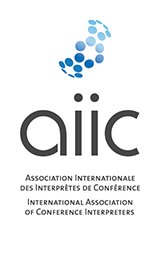
AIIC and distance interpreting
Distance interpreting enables us to deliver on our commitment to multilingualism where interpreters and active participants cannot be in the same location
Distance interpreting takes many forms: some, like video conference interpreting, are widely accepted as an additional service that interpreters can offer, whereas remote interpreting has been more controversial, mainly due to the reduced sensory input available to interpreters working in this modality. However, technological and societal changes have been reflected in AIIC’s evolving position towards remote interpreting as well as the potential it offers to bring multilingualism to a wider sphere. It is imperative, however, to ensure that the promise of widened multilingualism for our clients and employers is not thwarted by poor quality of service or the jeopardizing of interpreter health and well-being – or indeed both.
Keeping pace with developments
AIIC recognised at an early stage that distance interpreting can be an enabler to multilingualism, whilst constituting a growing market for the profession, with demand from clients increasing. The Association therefore chose to take a proactive role, intervening to ensure that the interests of all stakeholders, not only interpreters, are taken into consideration. To this end, the Executive Committee established the Taskforce on Distance Interpreting (TFDI) to provide advice and assistance on policy decisions concerning technical, physiological, psychological and practical considerations related to distance interpreting.
In 2020, the Covid-19 pandemic brought remote interpreting to the fore, putting pressure on interpreters, meeting organisers, institutional employers and equipment providers to quickly adapt to and embrace a new landscape where remote interpreting had suddenly become the dominant paradigm. AIIC immediately responded by offering guidelines, advice and practical solutions such that it could deliver on its commitment to multilingualism and interpreting the world, whilst ensuring quality of service and the protection of interpreter well-being and public health more broadly. Lasting foundations have thereby been laid in the interests of all stakeholders in effective multilingual communication.
Distance interpreting resources
AIIC’s Taskforce on Distance Interpreting has taken the lead in preparing guidance and information on distance interpreting since its inception, the Covid-19 pandemic triggering a dramatic increase in its output. Here are some selected resources:
── Distance interpreting definitions
Brief explanations of different types of distance interpreting: teleconference interpreting (video conference and audio conference) and remote interpreting (video remote and audio remote).
Results of the TFDI’s early-2018 association-wide online survey on the frequency of use of different distance interpreting modalities, based on answers from 664 members relating to their experiences of four different types of distance interpreting.
── AIIC Position on Distance Interpreting
Recognising that distance interpreting modalities are perceived by conference interpreters as fundamentally different to face-to-face interpreting and that they require clearly defined and modality-specific working conditions, in 2018 AIIC made a commitment to develop and adopt evidence-based working conditions for distance interpreting.
── AIIC Guidelines for Distance Interpreting (Version 1.0)
Minimum standards and best practice recommendations applicable to working conditions for video remote conference interpreting in simultaneous mode, including for sign language interpreting.
── AIIC Best Practices for Interpreters during the Covid-19 crisis
Joint guidelines from AIIC's Technical and Health Committee & Taskforce on safe remote interpreting practices to assist interpreters and those responsible for their safety during the Covid-19 pandemic
── AIIC Covid-19 Distance Interpreting Recommendations for Institutions and DI Hubs
The TFDI prepared a set of recommendations for institutions and DI hubs available to all stakeholders in the interpretative process to ensure that multilingual meetings could continue despite the extraordinary circumstances brought about by the Covid-19 pandemic.
── Covid-19: Advice on performing interpreting assignments from home in extremis
Minimum standards and best practice recommendations applicable to working conditions for video remote conference interpreting in simultaneous mode, including for sign language interpreting.
A detailed checklist for all stakeholders in interpreted multilingual communication, covering all stages of interpreting assignments, including technical and contractual considerations, training and testing.
